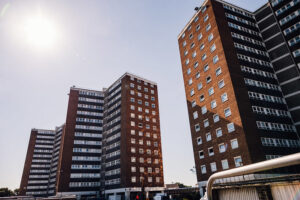Council seeks to develop HGV, bus and diesel vehicle policies following low emission zone feasibility study findings
Further work is needed to cut air pollution from buses, heavy goods vehicles and diesel cars in Bradford, the city council has concluded, following the findings of its low emission zone (LEZ) feasibility study.
First presented to the council in November 2014, the LEZ study concluded that there was a “substantial health burden” related to emissions from vehicles in the area, and that this burden was “born disproportionately by the most deprived in Bradford”.

Bradford city hall – the council is looking at developing policies to cut diesel car numbers on the city
The study, which was funded through a £102,000 Defra grant, concluded that “significant” emission reductions of nitrogen oxides (NOx) could be made in the city by improving bus and HGV engines to Euro VI exhaust standards in the inner and outer ring road areas.
It also found that reversing the increase in diesel passenger cars to year 2000-levels of 20% of the fleet or less, as well as cutting the number of passenger cars overall in the city by 10% in favour of public transport, walking and cycling could help to improve air quality.
And, while the council has ruled out an outright ban on diesel cars in the city, a report to a meeting of the executive tomorrow (March 10) recommends that “further work” is carried out towards reducing emissions from buses and HGVs, encouraging alternative travel options and reducing the proportion of diesel cars and taxis in Bradford.
Although specific policies in these areas have not yet been outlined, the council report recommends that officers review and update Bradford’s 2013 Low Emission Strategy (see airqualitynews.com story) in view of the LEZ study’s findings and to explore the “impact, benefits and issues around the practical implementation” of an LEZ.
However, policies could include the “most cost effective option” recommended in the LEZ study, which would be the introduction of an LEZ requiring bus operators to meet the Euro VI standard but also converting to compressed natural gas (CNG) buses.
According to the report, 55% of bus movements in the city centre in 2012 were Euro III standard or older, while 40% of emissions within the inner ring road can be attributed to buses.
The council also stressed that the LEZ study’s findings would be a “key point” in negotiations to introduce a West Yorkshire-wide Oyster card-style system as part of the establishment of a legally-binding Quality Bus Partnership.
This work will also feed into a West Yorkshire project to develop a low emission strategy for all five authorities in the region with the assistance of Public Health England.
According to the council last week: “While this [LEZ feasibility] study provides an indication of the feasibility of introducing Low Emission Zones type measures, further work will be required to develop identified possibilities into worked through policy measures.”















